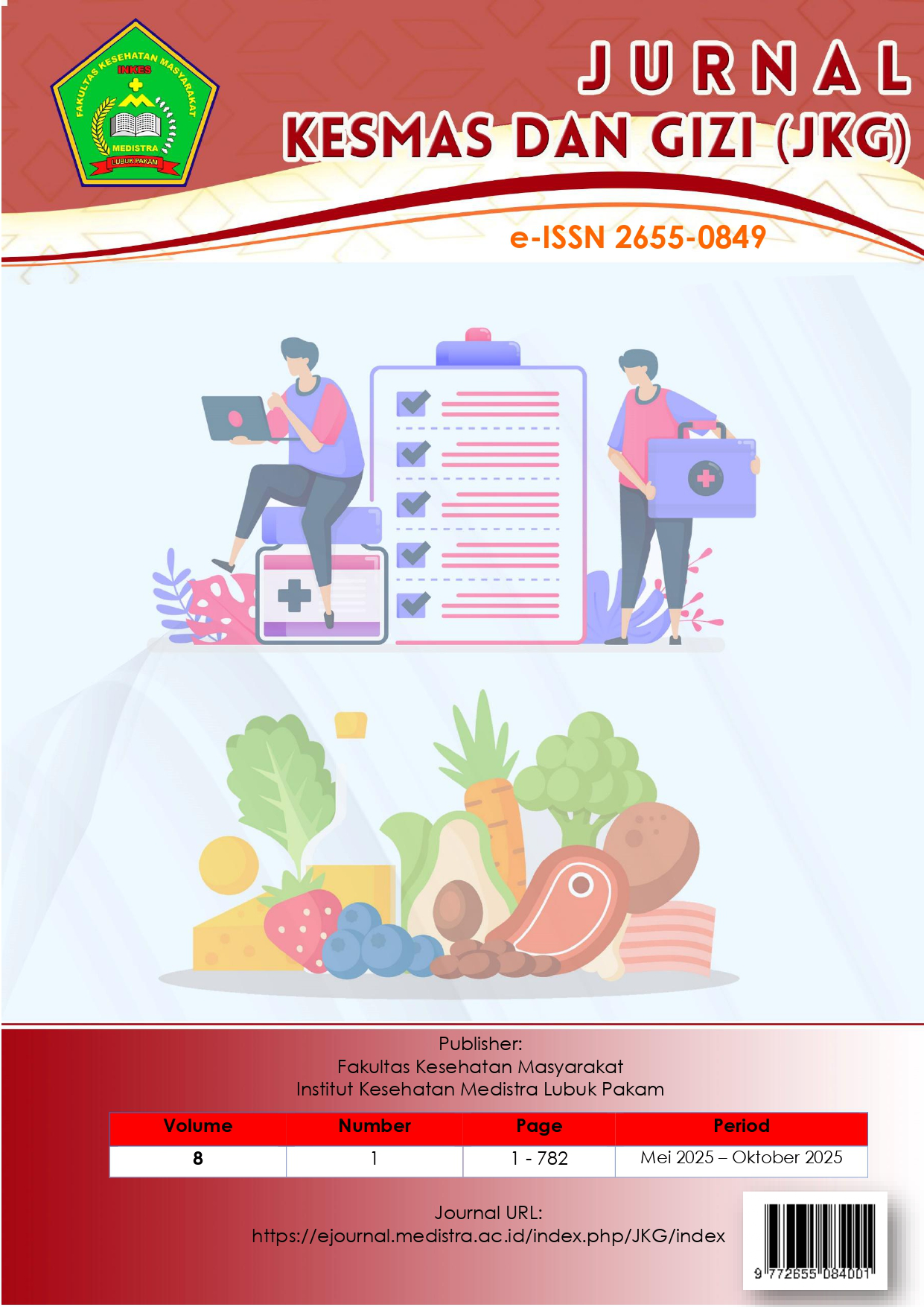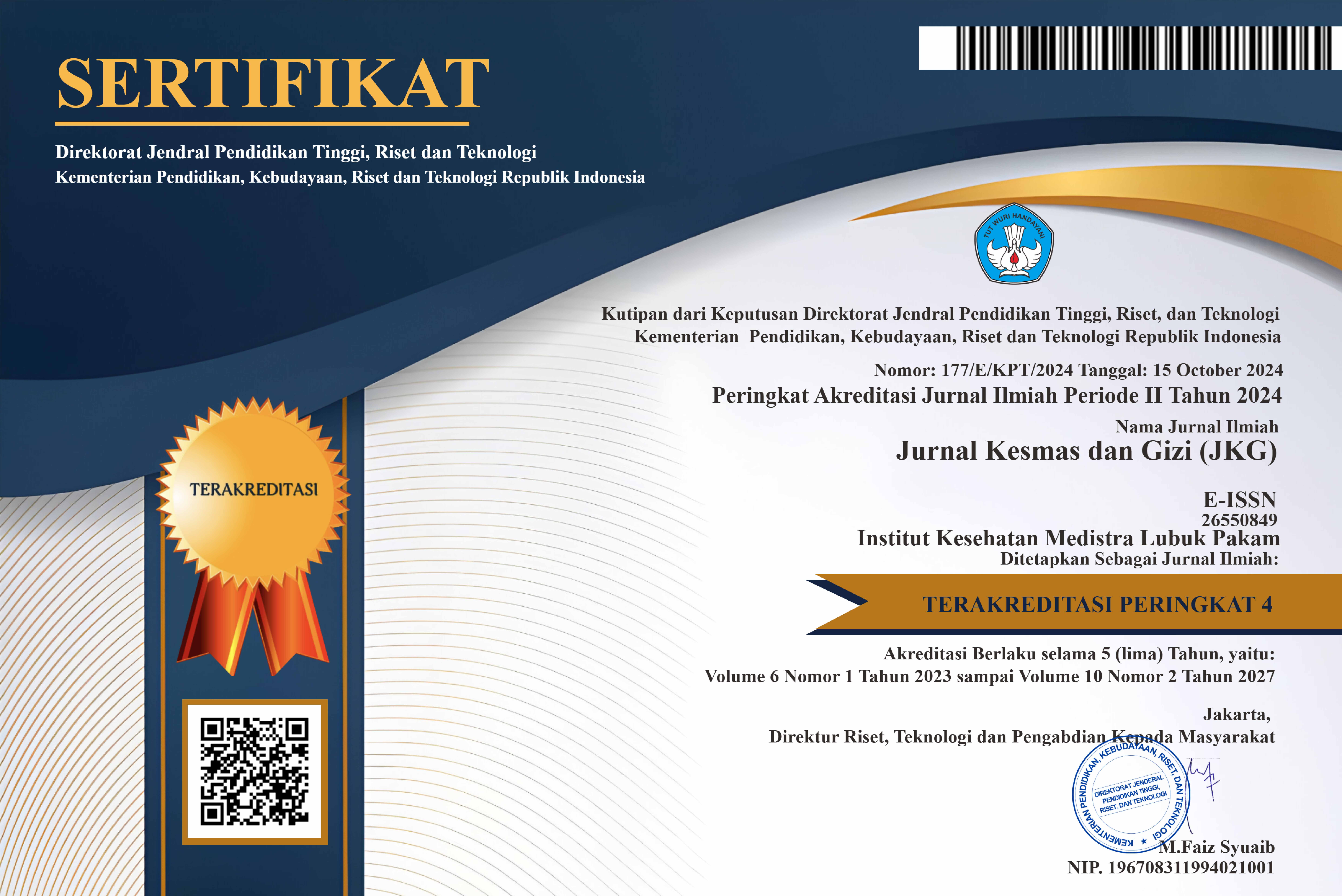The Relationship Between Fast Food Consumption Habits and Physical Activity with the Incidence of Obesity Among Pharmacy Students at the Medistra Institute of Health, Lubuk Pakam
DOI:
https://doi.org/10.35451/2ketj113Keywords:
fast food, physical activity, obesity, university studentsAbstract
Obesity is a growing public health issue, particularly among young adults such as university students. Lifestyle changes characterized by high consumption of fast food and low levels of physical activity are major contributing factors to the increasing prevalence of obesity. This study aimed to examine the relationship between fast food consumption habits and physical activity levels with the incidence of obesity among students of the Pharmacy Study Program at Medistra Health Institute, Lubuk Pakam. This research employed an analytical observational design with a cross-sectional approach. The sample consisted of 59 students, selected using a simple random sampling technique. Data were collected using a Food Frequency Questionnaire (FFQ) to assess fast food consumption habits, physical activity questionnaires to determine activity levels, and waist circumference measurements as an indicator of central obesity. Data were analyzed using the Spearman rho correlation test with a significance level of p < 0.05. The results showed a significant relationship between fast food consumption habits (r = 0.596; p < 0.05) and physical activity (r = 0.389; p < 0.05) with obesity incidence among students. The findings indicate that students who frequently consume fast food and engage in low levels of physical activity are at a higher risk of developing obesity. In conclusion, unhealthy eating patterns and sedentary lifestyles are key factors contributing to obesity among young adults; therefore, preventive efforts through nutrition education and the promotion of regular physical activity are necessary within the university environment.
Downloads
References
[1] Netty, Agus Jalpi, and Nurul Indah Qariati, “Hubungan Pengetahuan, Frekuensi Konsumsi Fast Food dan Genetik dengan Kejadian Obesitas Mahasiswa Fakultas Kesehatan Masyarakat Uniska MAB Banjarmasin,” Promot. J. Kesehat. Masy., vol. 12, no. 2, pp. 142–146, Dec. 2022, doi: 10.56338/promotif.v12i2.2732.
[2] H. S. Nasution, M. Ridwan, and E. Wisudariani, “Pembentukan Posbindu Penyakit Tidak Menular Institusi Dalam Mendukung Kampus Sehat,” JMM (Jurnal Masy. Mandiri), vol. 7, no. 2, p. 1619, Apr. 2023, doi: 10.31764/jmm.v7i2.13928.
[3] R. Fitriyanti, R. Prikhatina, and Z. Shabrina, “Pengaruh Frekuensi Konsumsi Fast Food Terhadap Kejadian Obesitas pada Mahasiswa Gizi Universitas MH. Thamrin,” J. Sains Kesehat., vol. 31, no. 1, pp. 20–25, Aug. 2024, doi: 10.37638/jsk.31.1.20-25.
[4] linda putri anggraini and M. A. Sodik, “Fast Food, Junk Food, dan Dampaknya Bagi Kesehatan.” Oct. 17, 2018. doi: 10.31219/osf.io/9xtc8.
[5] I. N. Amelia and A. Syauqy, “Hubungan Antara Asupan Energi Dan Aktivitas Fisik Dengan Persen Lemak Tubuh Pada Wanita Peserta Senam Aerobik,” J. Nutr. Coll., vol. 3, no. 1, pp. 200–205, Jan. 2014, doi: 10.14710/jnc.v3i1.4559.
[6] V. Rahmalia and T. K. Karjoso, “Pengaruh Konsumsi Fast Food terhadap Kejadian Obesitas pada Remaja : Literature Review,” Media Publ. Promosi Kesehat. Indones., vol. 6, no. 9, pp. 1753–1759, Sep. 2023, doi: 10.56338/mppki.v6i9.3665.
[7] L. Ferdianti, “Literature Review : Hubungan Aktivitas Fisik dan Kebiasaan Konsumsi Fast Food dengan Kejadian Obesitas Pada Anak Sekolah Dasar,” MEDIA Kesehat. Masy. Indones., vol. 20, no. 2, pp. 139–143, Apr. 2021, doi: 10.14710/mkmi.20.2.139-143.
[8] S. Hanafi and W. Hafid, “Hubungan Aktivitas Fisik dan Konsumsi Fast Food dengan Kejadian Obesitas Pada Remaja,” Kampurui J. Kesehat. Masy. (The J. Public Heal., vol. 1, no. 1, pp. 6–10, Dec. 2019, doi: 10.55340/kjkm.v1i1.49.
[9] M. S. Irdianty and F. N. Sani, “Perbedaan Aktivitas Fisik Dan Konsumsi Camilan Pada Remaja Obesitas Di Kabupaten Bantul,” J. Kesehat. Kusuma Husada, pp. 91–97, Jan. 2018, doi: 10.34035/jk.v9i1.265.
[10] N. Nabawiyah, Arneliwati Arneliwati, and Yesi Hasneli N, “Hubungan Tingkat Aktivitas Fisik Dengan Kejadian Obesitas Pada Remaja,” Detect. J. Inov. Ris. Ilmu Kesehat., vol. 1, no. 1, pp. 14–26, Jan. 2023, doi: 10.55606/detector.v1i1.1022.
[11] R. Daka, E. Martha, L. P. A. Dewiyanti, and E. Habina, “Faktor-faktor yang Mempengaruhi Kejadian Obesitas Pada Remaja di Indonesia (Literatur Review),” J. Ners, vol. 9, no. 2, pp. 3190–3205, Apr. 2025, doi: 10.31004/jn.v9i2.40021.
[12] I. S. Nasution et al., “Analisis Gaya Hidup Tidak Sehat Pada Mahasiswa FKM UIN Sumatera Utara: Potensi dan Hambatan dalam Mewujudkan Perilaku Hidup Sehat,” QISTINA J. Multidisiplin Indones., vol. 4, no. 1, pp. 600–608, Jun. 2025, doi: 10.57235/qistina.v4i1.6191.
[13] R. Panjaitan, R. Irwanto, A. Boffil Cholilullah, and S. Angraini, “Hubungan Pola Makan Terhadap Status Gizi Pasien Rawat Jalan Diabetes Melitus Tipe 2 Di Wilayah Kerja Rumah Sakit Grandmed Lubuk Pakam,” J. KESMAS DAN GIZI, vol. 3, no. 2, pp. 168–171, Apr. 2021, doi: 10.35451/jkg.v3i2.660.
[14] A. B. Putri and A. Makmun, “Pola Makan terhadap Obesitas,” Indones. J. Heal., pp. 68–76, Oct. 2021, doi: 10.33368/inajoh.v2i1.39.
[15] A. Zahirah Putri, J. Juhairina, I. Istiana, T. Triawanti, and D. Setyohadi, “Hubungan Asupan Energi Dan Serat Dengan Kejadian Obesitas Pada Mahasiswa Pskps Fk Ulm TAHUN 2022,” Homeostasis, vol. 6, no. 1, p. 1, May 2023, doi: 10.20527/ht.v6i1.8782.
[16] N. M. Intan Permatasari, “Hubungan Konsumsi Fast Food Dengan Kejadian Obesitas Pada Remaja Di Indonesia: Kajian Pustaka,” Arch. COMMUNITY Heal., vol. 11, no. 2, p. 375, Aug. 2024, doi: 10.24843/ACH.2024.v11.i02.p08.
[17] P. Jia et al., “Environmental determinants of childhood obesity: a meta-analysis,” Lancet Glob. Heal., vol. 11, p. S7, Mar. 2023, doi: 10.1016/S2214-109X(23)00092-X.
[18] A. I. Yuliana, M. Faizah, F. N. Azimah, H. A. Rofendi, and R. Ummah, “Edukasi Kesehatan : Bahaya Konsumsi Fast Food pada Mahasiswa Fakultas Pertanian Universitas KH. A. Wahab Hasbullah,” Jumat Pertan. J. Pengabdi. Masy., vol. 4, no. 2, pp. 64–67, Aug. 2023, doi: 10.32764/abdimasper.v4i2.3885.
[19] E. A. Chávez-Manzanera et al., “Mexican Clinical Practice Guidelines for Adult Overweight and Obesity Management,” Curr. Obes. Rep., vol. 13, no. 4, pp. 643–666, Oct. 2024, doi: 10.1007/s13679-024-00585-w.
[20] R. Ali and N. Nuryani, “Sosial Ekonomi, Konsumsi Fast Food Dan Riwayat Obesitas Sebagai Faktor Risiko Obesitas Remaja,” Media Gizi Indones., vol. 13, no. 2, p. 123, Oct. 2018, doi: 10.20473/mgi.v13i2.123-132.
Downloads
Published
Issue
Section
License
Copyright (c) 2025 Dian Novita, Nabilah Bilqis, Salmi Angraini, Edarni Zebua, Desri Meriahta Br Girsang

This work is licensed under a Creative Commons Attribution 4.0 International License.
Copyright in each article is the property of the Author.


























